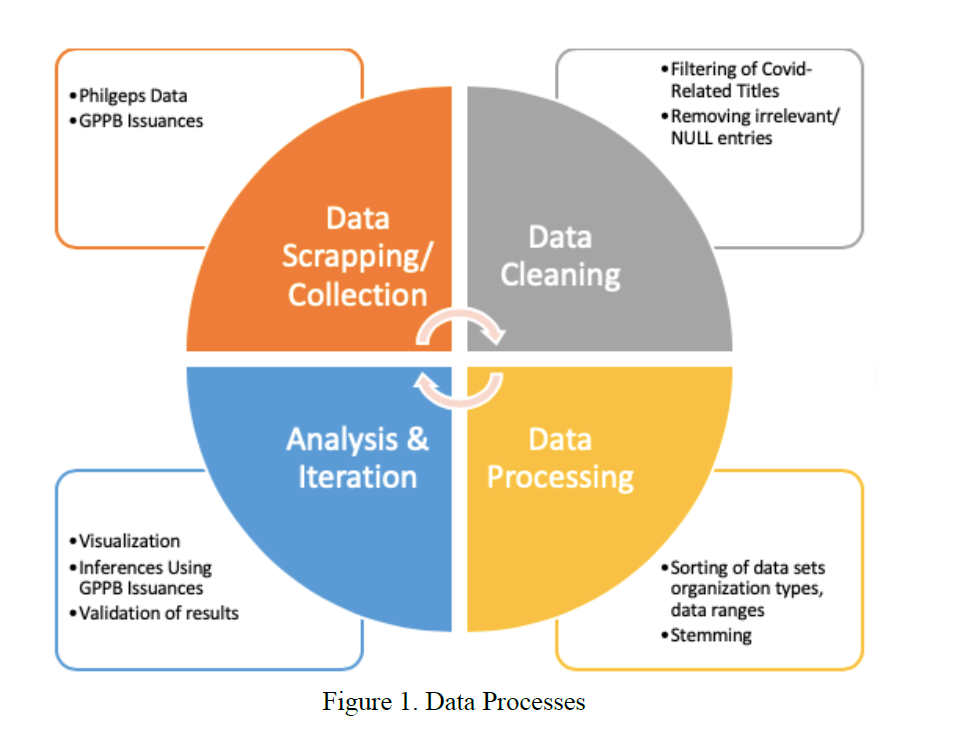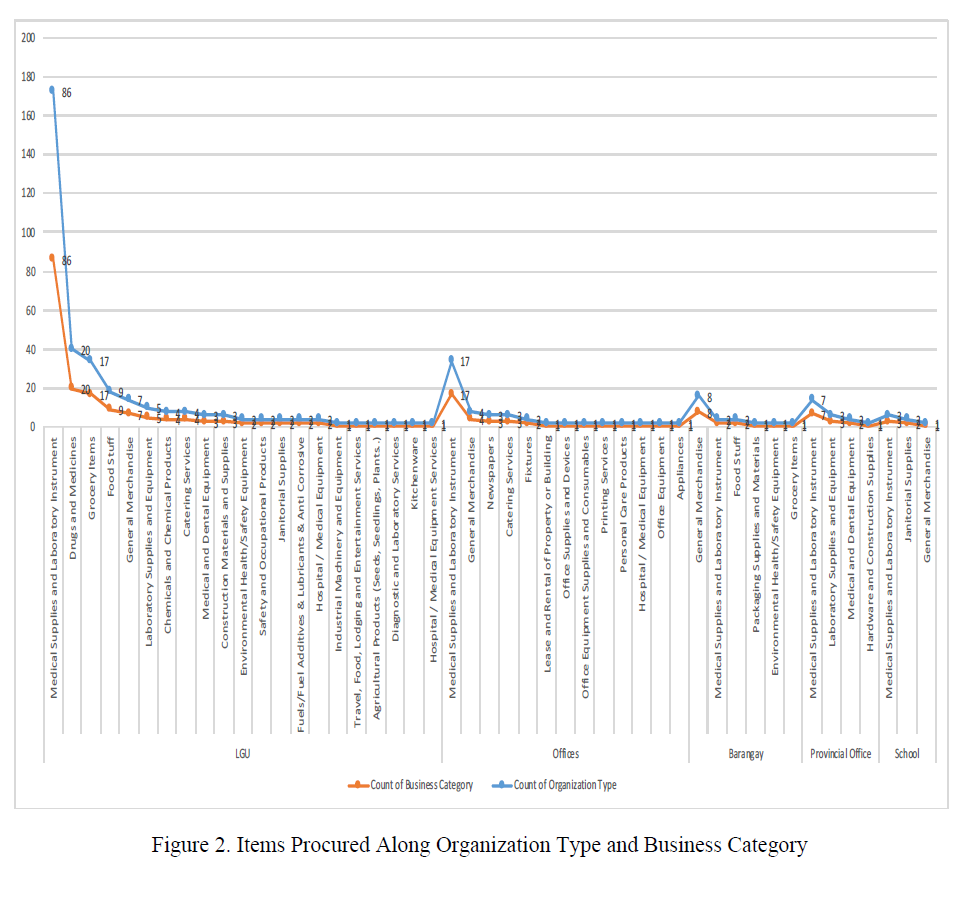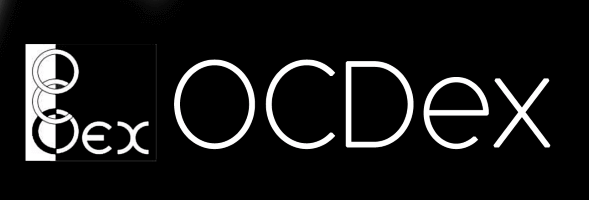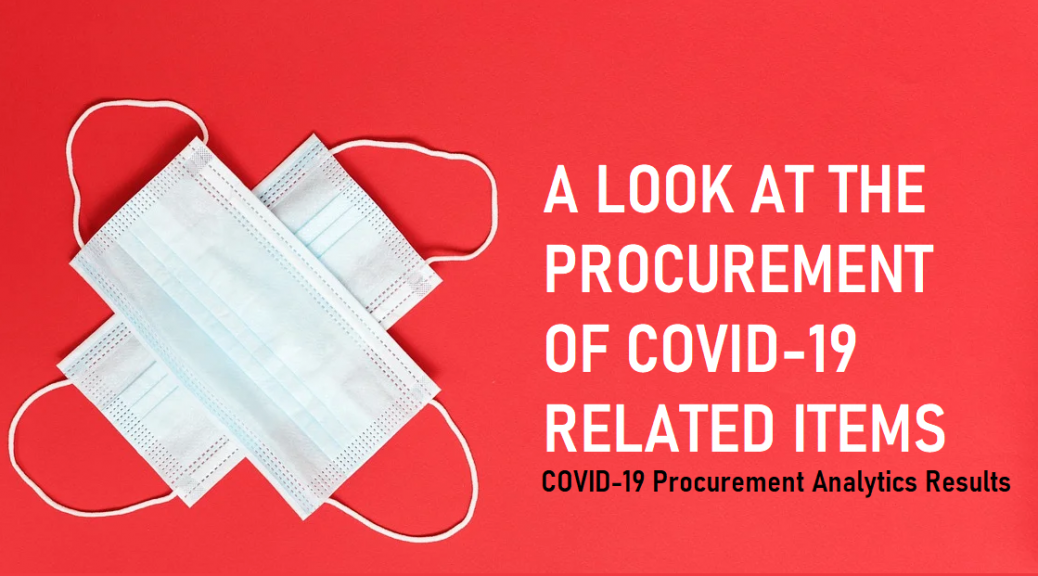(This article and the manuscript were submitted by the research team and may be updated/revised in the future)
With the widespread of COVID-19 as an infectious disease caused by a newly discovered coronavirus, the Philippines had a large number of confirmed cases reported from early of this year up to the present. This research deemed it necessary to determine and analyze the procurement transactions made by the Philippine Government as response measures during the first quarter of the Covid-19 pandemic occurrence in the country. This may serve as baseline data in the preparation of the Annual Procurement Plan (APP) and/or the supplemental one to respond to Covid-19 crisis. Particularly, this intends to identify the items procured during the first quarter by the government agencies as response measures to Covid-19 pandemic. It also evaluates the transaction details of the procured items, and determine the response measures initiated by the government agencies as precautionary to the spread of Covid-19.
How did we go Through the Process?
This research employed the data analytics methods by observing the steps as depicted in Figure 1 such as data scraping, data cleaning, data processing, and data analysis and iteration.

Data scraping: The collection of data was made through data scrapping from PhilGeps website along Bid Notice and Award Details for the first quarter of year 2020, that is from January to March 2020. As to procurement data within the duration period, the total number of collected datasets were 231,784. However, focusing primarily on Covid-19 procurement and removing the non-covid related procurement, this resulted to 245 data sets only. Other legitimate sites such as GPPB and DOH were also looked into. From Regions 1 to 15 including NCR, this was well-represented by various government agencies with 22 offices, 5 public schools, 8 barangays, 73 LGUs, and 9 Provincial Offices.
Data Cleaning: This includes the processes of filtering the PhilGeps procurement data if it is Covid-related based on its notice titles, item name and descriptions. Filtering also involves selecting the necessary fields found relevant on the analysis of data such as organization name, business category, funding source and instrument, notice type, procurement mode, area of delivery and the like since the datasets to be collected may be in the form of a machine-readable format. The keywords used were “covid” and “covid-19.” Other irrelevant fields and with NULL entry were removed.
Data Processing. After cleaning the datasets, the organization names were grouped accordingly to its organization type to come up with a collective view. Stemming was used for the item descriptions and business category for easier analysis to remove the inflexional and/or sometimes the derivational. The approved budget was also sorted into data ranges. The “count” value were used in the analysis of each unique instances. The purpose of those processes was to get the unique value of each data to give meaning and help in telling the stories.
Data Analysis and Iteration: Visualization of each significant findings was made by curating data into a form easier to understand and make the necessary inferences on the results as per GPPB and DOH issuances. Afterwards, consultation with the Legazpi City LGU procurement personnel shall be made for presentation and validation of results. Further improvement shall be considered on the processing of next iteration of the study.
Results:
Items Procured During the First Quarter by Government Agencies as Response Measures to Covid-19 Pandemic
The items procured in terms of its business category by various government agencies as represented by the five (5) organization types is shown in Figure 2. Results revealed that the LGU, offices, provincial offices, and schools similarly had the medical supplies and laboratory instruments as their top procurement priorities during the first quarter of 2020 as prevention and response for Covid-19. General merchandise such as other supplies, printing, information materials, and the like, followed by drugs and medicines were found to be the next top-most procured items by the various government agencies especially those at the barangay levels. Since even during the early times of pandemic, some families and even individuals got displaced, that is why groceries had also been part of the most procured items especially by the LGUs. It is good to note that LGU took the lead in taking its initiative for the prevention of the spread of virus.

Findings also showed that Region 7 or Central Visayas, particularly Cebu City, had made the most number of procured items on medical supplies and laboratory instrument, and drugs and medicines during the first quarter of 2020. Region 1 or Ilocos as they also had a big count of purchases on medical supplies and laboratory instrument and so with the other item categories. Next to it were Regions 8 of Eastern Visayas and NCR with medical supplies and laboratory equipment, and general merchandise respectively.
Transaction Details of the Procured Items
Majority of the funding source and instrument of the procured items had its budget for the contract as approved by the Sanggunian followed by those from the General Appropriations Act (GAA). With the holistic view, since the study covered the various government agencies such as LGU, public offices and schools, this showed the utilization of two (2) alternative procurement modes. Results inferred that most of the procurement mode is on alternative mode which is Negotiated Procurement-Small Value Procurement followed by those posted from public bidding.
As to the budget utilization, for the barangays, the top-most procured items was on general merchandise with budgets ranging from 501,000 to 1M. With the LGUs, medical supplies and laboratory instruments with an
approved budget of 400,000 to 1.5M was the top procured items. Grocery items were also found to be one of the most procured items by the LGUs to address the need of the displaced families and individuals with an approved budget ranging from 51,000 to 100,000. Almost similarly, other government offices had also the medical supplies and laboratory instruments as the most procured items during the first quarter of 2020 with approved budgets ranging from 51,000 to 4M and general merchandise also as the next most procured items. Further, the provincial offices and schools had similar to other government agencies on the top-most procured items which is medical supplies and laboratory instruments with budgets ranging from 251,000 to 8M and 51,000 to 400,000 respectively.
As part of the procurement process, based on the procurement details on the first quarter of this year, mostly of the award notice granted was on negotiated procurement on emergency cases. Notably, the lowest calculated and responsive bidder, and emergency cases were most of the reasons in giving the award to the concerned suppliers. Other reasons for award shown were lowest calculated and responsive price quotation and most reliable supplier.
Response Measures Initiated by Government Agencies as Precautionary Measures to Covid-19
The response measures initiated by various government agencies as precautionary measures to Covid-19 were identified based on their procured items during the first quarter of 2020. Findings revealed that from among the various government agencies in the country, foremost of the precautionary measures conducted were the availability of medical supplies for the preparedness and response, distribution of relief goods for the displaced families and individuals, the conduct of sanitation, and taking the initiative in disseminating information through an information drive such as seminars or orientation and printing of tarpaulins relating to Covid-19 preventive measures. Most of the measures were initiated by the LGUs and this may be inferred to the idea that the front liners were mostly came from the LGUs.
Significant Highlights:
The LGU, offices, provincial offices, and schools similarly had the medical supplies and laboratory instruments as their top procurement priorities during the first quarter of 2020 as prevention and response for Covid-19 followed by general merchandise especially those at the barangay levels. Region 7 or Central Visayas particularly Cebu City had the most number of procured items of medical supplies and laboratory instrument, and drugs and medicines during the first quarter of 2020. As to area of delivery, Region 1 or Ilocos had the biggest count of purchases followed by Regions 8 of Eastern Visayas and NCR. Majority of the funding source and instrument of the procured items came from the Government of the Philippines
(GOP) with the budget for the contract of 51,000 to 4M as approved by the Sanggunian followed by those from the General Appropriations Act (GAA). Most of the procurement mode is on Negotiated Procurement-Small Value Procurement followed by those posted from public bidding. And, foremost of the precautionary measures conducted were the availability of medical supplies for the preparedness and response, distribution of relief goods for the displaced families and individuals, the conduct of sanitation, and taking the initiative in disseminating information through an information drive relating to Covid-19 preventive measures.
Conclusions
Based on the foregoing findings, the study concluded that the various government agencies had shown limited procurements on covid-related items in preparation for the pandemic although the LGUs had the most procured items during the first quarter of 2020 on medical supplies and laboratory equipment. The procurement processes adheres to the rules on Negotiated Procurement (Emergency Case) as stipulated in the GPRA. In addition, a number of precautionary measures were conducted by the various government agencies in the Philippines although further measures with urgency should still be initiated to help control the virus transmission nationwide and even worldwide.
What’s Next?
The study recommended that there should be procurement of materials to be used for sanitation and protocol set-up as preventive measures for the spread of Covid-19 especially to quarantine areas and other public areas mostly visited by community members. Said items may be considered in the preparation of the Annual Procurement Plan (APP) and/or the supplemental one to respond to covid-19 crisis. It is also suggested for the GPPB to formulate a policy guideline by expediting the procurement processes through an online platform by designing a Decision Support attributes in the system to further promote transparency and competitiveness. Lastly, there should be an urgency on the procurement of the most needed medical
supplies and laboratory equipment to strictly implement the health protocols to help address the increasing number of PUM’s, PUI’s and LSI.
READ the FULL ARTICLE (with figures below)
 Loading…
Loading…
Get the presentation slides for this study:
 Loading…
Loading…
Watch the online presentation of the findings:
References:
Cebu City Placed Under Community Quarantine. https://rappler.com/nation/cebu-city-quarantinemarch-
16-2020. March 15, 2020.
Data Science Guide. Exploratory Data Analysis. https://datascienceguide.github.io/exploratory-dataanalysis
https://www.gppb.gov.ph/issuances/Resolutions/GPPB%20Resolution%20No.%2009-
2020%20with%20SGD.pdf
Peter Bruce and Andrew Bruce. Practical Statistics for Data Scientists.
https://learning.oreilly.com/library/view/practical-statistics-for/9781491952955/
PhilGeps. (ADV2020-007) Advisory For Client Agencies In Relation To The Declared Enhanced Community
Quarantine. www.philgeps.gov.ph, March 17, 2020.
PhilGeps. Revised Implementing Rules And Regulations Of Republic Act No. 9184, Otherwise Known As
The Government Procurement Reform Act. www.philgeps.gov.ph, n.d.
Sievo Global Headquarters, Procurement Analytics Demystified, www.sievo.com, n.d.
The 2016 Revised Implementing Rules and Regulations of Republic Act No. 9184, otherwise known as
the Government Procurement Reform Act.
http://www.bsp.gov.ph/downloads/procurement/IRR_RA9184.pdf. n.d.
The 2016 Revised Implementing Rules and Regulations of Republic Act No. 9184, Otherwise Known as
the Government Procurement Reform Act.
https://www.officialgazette.gov.ph/images/uploads/20160826-IRR-RA-9184-procurementreform.
pdf

